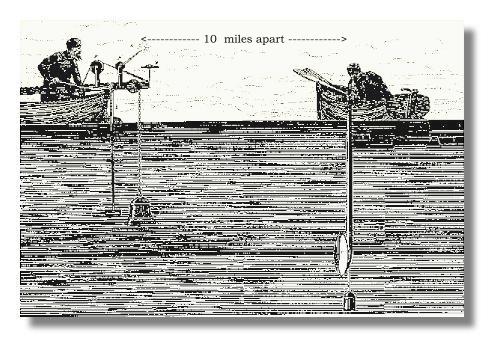Jean Daniel Colladon founds ultrasound sonography

Jean Daniel Colladon was born December 15,1802 in Geneva, Switzerland. One of his greatest acomplishments was in ultrasound sonography. He studied law, but was more interested in math and science. The physics of water and light intrigued him. He spent the rest of his life in the persuit of natural phenomena.
In 1826, Colladon used a church bell under water to prove that sound traveled faster through water than air. In lake Geneva, assisted by Charles-Francois Sturm, a mathematician, the two split apart by ten miles in boats. One struck the bell underwater and ignited gunpowder above the surface at the same time. With the other positioned Ten miles away, they started timing at the flash of the gunpowder and stopped the timer when the sound arrived later, using a trumpet-like instrument. A crude ultrasound amplifier. Related topic The Doppler effect Despite their simple devices, They calculated the speed of sound underwater at 1435 meters/second. See ultrasound A number that is close to today's known standard. It has evolved into its own science and even though Colladon used a simple ultrasound amplifier, he paved the way for the transducer.

At 38, as a professor at the University of Geneva, he demonstrated the guiding of light ( called TIR ) through a curved object. He was trying to demonstrate water jets and their breaking up. He had a tank of water with small holes in it for the water to stream out. The students couldn't see from a distance, so he piped light through a tube into the tank and into the streams of water. The light bended with the water. He found that ultrasound sonography had the same physics as light as they both travel in waves. Colladon later wrote: "I managed to illuminate the interior of a stream in a dark space. I have discovered that this strange arrangement offers in results one of the most beautiful, and most curious experiments that one can perform in a course on Optics." He then became professor of mechanics at Ecole Centrale Paris in 1829. He returned to Switzerland in 1839 and organized the gas lighting of Geneva and Naples. He also invented the dynamometer ( an instrument for measuring power ) and developed the use of energy stored in compressed air for tunneling operations in 1852.But his discovery of the speed of sound under water paved the way for modern
ultrasound sonography. Pierre Curie made the next breakthrough
You may want to find out about what this discovery evolved into. Please check
types of ultrasound
back to history
Genesis ultrasound machine home page




